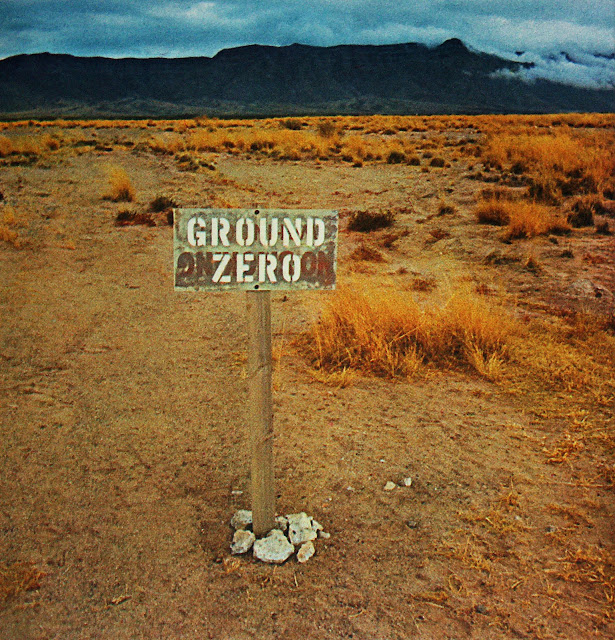An everyday massacre, the obscene reality of occupation.
In New Baghdad on the twelfth of July 2007, death rained down from the 30mm cannons of two Apache gunships. (And let us not miss the history of blood and original accumulation condensed in that linguistic expropriation: a name stolen from a people who symbolize indigenous resistance is now the trophy-scalp decorating a flying weapons platform of US Army Air Cavalry, successors of the horseback troopers who chased Geronimo.)
The problem of enjoyment – of “war porn” – in this video released through WikiLeaks is glaring: the images of a dozen people slaughtered from the air do not in themselves exclude fantasmatic identifications with the voices heard and, through them, with the power of these weapons and the war machine as such. Similar images, seen countless times in the entertaining fodder of the cinema of war, erode the power to hold apart fiction and real killing.
There is a habitual structure of projective identification activated here that holds out something like a spectatorial path of least resistance. It tends to suck us in and place us, so that we assume a certain position and point of view in the antagonistic scenario. And this of course is exactly how movies and video games work. The template of entertainment matches the actual massacre.
Watching this video aligns us, like it or not, with the occupier's gaze, the soldiers' gunsights - behind which, the god's eye vantage of fantasmatic power. (The cameras of the murdered journalists would give us a very different vantage and image: see the negative presentation below.)
The fantasy of omnipotence is of course only a fantasy: the murderous paranoia of the soldiers, seeing weapons and enemies everywhere, betrays this clearly. Such paranoia is structurally produced by the occupation itself: they are manifesting the survival imperatives of occupiers (which does damage to them as well). But the ethical lapse this entails is mirrored and encouraged by the structure and template of the video image. The fantasy of absolute power that activates these alignments sets up the possible enjoyment for spectators.
Even if - consciously, ethically, politically - we refuse with a fitting revulsion the point of view offered, the fantasy lure of power never ceases to call to us in ways we can't be certain we don't respond to unconsciously. Enjoyment, in this sense, doesn't exclude the displeasure of revulsion.
Ethical corruption and the attrition of outrage thus accompany such images, along with disgust and indignation. We're obligated to see and absorb this video, in order to witness what's being done. At the same time, we need to resist and palpate its insidious lures. Here as everywhere else, we have to struggle for our humanity.
WikiLeaks has undertaken with courage and diligence the tasks of decrypting exposure abandoned by a mainstream journalism castrated by its corporate owners. For that, it is under attack by numerous states and agencies, including the Pentagon – as even the New York Times acknowledged on 17 March.
In the struggles to resist neo-imperialism, the info wars remain a crucial battleground. Under conditions of integrated spectacle and stupefying concentrations of corporate power, access to truth and counter-images is fundamental. And we’re going to have to fight for it, as the blow US courts struck this week to the principle of net neutrality should alert us.
In New Baghdad on the twelfth of July 2007, death rained down from the 30mm cannons of two Apache gunships. (And let us not miss the history of blood and original accumulation condensed in that linguistic expropriation: a name stolen from a people who symbolize indigenous resistance is now the trophy-scalp decorating a flying weapons platform of US Army Air Cavalry, successors of the horseback troopers who chased Geronimo.)
The problem of enjoyment – of “war porn” – in this video released through WikiLeaks is glaring: the images of a dozen people slaughtered from the air do not in themselves exclude fantasmatic identifications with the voices heard and, through them, with the power of these weapons and the war machine as such. Similar images, seen countless times in the entertaining fodder of the cinema of war, erode the power to hold apart fiction and real killing.
There is a habitual structure of projective identification activated here that holds out something like a spectatorial path of least resistance. It tends to suck us in and place us, so that we assume a certain position and point of view in the antagonistic scenario. And this of course is exactly how movies and video games work. The template of entertainment matches the actual massacre.
Watching this video aligns us, like it or not, with the occupier's gaze, the soldiers' gunsights - behind which, the god's eye vantage of fantasmatic power. (The cameras of the murdered journalists would give us a very different vantage and image: see the negative presentation below.)
The fantasy of omnipotence is of course only a fantasy: the murderous paranoia of the soldiers, seeing weapons and enemies everywhere, betrays this clearly. Such paranoia is structurally produced by the occupation itself: they are manifesting the survival imperatives of occupiers (which does damage to them as well). But the ethical lapse this entails is mirrored and encouraged by the structure and template of the video image. The fantasy of absolute power that activates these alignments sets up the possible enjoyment for spectators.
Even if - consciously, ethically, politically - we refuse with a fitting revulsion the point of view offered, the fantasy lure of power never ceases to call to us in ways we can't be certain we don't respond to unconsciously. Enjoyment, in this sense, doesn't exclude the displeasure of revulsion.
Ethical corruption and the attrition of outrage thus accompany such images, along with disgust and indignation. We're obligated to see and absorb this video, in order to witness what's being done. At the same time, we need to resist and palpate its insidious lures. Here as everywhere else, we have to struggle for our humanity.
WikiLeaks has undertaken with courage and diligence the tasks of decrypting exposure abandoned by a mainstream journalism castrated by its corporate owners. For that, it is under attack by numerous states and agencies, including the Pentagon – as even the New York Times acknowledged on 17 March.
In the struggles to resist neo-imperialism, the info wars remain a crucial battleground. Under conditions of integrated spectacle and stupefying concentrations of corporate power, access to truth and counter-images is fundamental. And we’re going to have to fight for it, as the blow US courts struck this week to the principle of net neutrality should alert us.

Photo is from Gardez, Afghanistan, on the wake of the 12 February killing of five people, including two pregnant women, by US Special Forces.
Glenn Greenwald reports on the campaign against WikiLeaks, the growing fury over the posted video of the 2007 massacre, and the politics of net neutrality in a series of articles for salon.com.
On Democracy Now! Amy Goodman goes over the video with WikiLeaks editor Julian Assange. Families of the victims respond.
A more rigorous analysis of the video in context with Assange on Al Jazeera, 19 April.




No comments:
Post a Comment